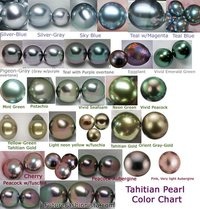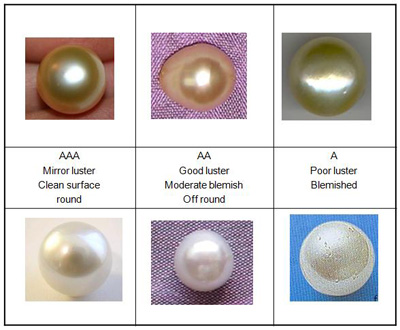Knowledge is power. Here’s what you need to know to shop wisely for your pearls. I’ll focus on salt water pearls for most of this as they are more expensive & it is easier to make a pricey mistake.
The most obvious trait of pearls is COLOR. South Sea pearls come in various shades of white, silver, peach, champagne to gold:
Tahitian pearls come in a rainbow of colors. Here are some examples of colors available besides the better known blacks:
Pistachio & neon green are probably the most expensive.
Due to their reflectivity, pearls tend to take on the color of their surroundings, so the best way to judge color is to drop them into a white styrofoam coffee cup (not paper!) & look down at them, preferably in natural daylight (or equivalent). I actually take a cup with me when shopping for pearls. Many reputable sellers will have a cup for you to use as well. Having a cup or asking for one will make you look like an informed buyer.
If you are buying a string of colored pearls, they should all match well. Some designers are making multi-color pieces, in which case the variety should be complementary & pleasing. For example, in a strand of white & black pearls, the whites should generally match each other & the blacks should match each other.
LUSTER is what pearls are all about. Akoyas should have a near-mirror finish–you should actually be able to see your reflection in them. South Sea and Tahitian have a more satiny finish, but should still look aglow.
SHAPE is a major determinator of cost and was touched on in my last blog. While all quality factors are important, here are the general values of different shapes:
SURFACE flaws can dramatically alter value. Remember, the longer a pearl grows (i.e. the bigger it is), the more likely it is to have flaws & flaws in larger pearls are more tolerable than they would be in smaller pearls.
Most common are pits & dimples (tiny lumps). As long as they are minor and covered in nacre, a few are acceptable.
You can also commonly see wrinkles & rings. Shallow rings filled with uniform color are less serious than deep rings in contrasting colors. While one or a few well-placed rings may look interesting on a baroque pearl, excessive ringing can make pearls look artificial.
All flaws are going to be more noticeable on solitary pearls (earrings, pendants, rings, etc) compared to strings.
As you see in the chart above, pearls are commonly graded AAA-A down to D. Remember that there is NO internationally accepted grading standard, so use the grades only to compare pearls from one source. That said, it is reasonable to expect AAA or AA pearls to be very nice.
SIZE is also a consideration & is pretty self explanatory. Traditionally, pearl strands are graduated with the largest in the center front, tapering in size towards the back. In this case, the gradation of size should be symmetrical on both sides. Some strands are uniform in size. Here, the nicest pearls should be front & center.
PRESENTATION refers to how the piece is assembled. Traditional fine pearl strands are hand knotted on silk cord with a knot (or two) between each pearl. This technique prevents loss of pearls if the cord breaks (which it will) & makes the strand a bit longer than if there were no knots. Most sources recommend that you have your pearls restrung every 1-2 years as the cord will deteriorate. This can cost $100 or more. I use a more modern approach and usually wrap my pearls on 20 gauge silver or gold wire. This is a permanent attachment that is very secure. While I can easily re-string my own pearls, I prefer the more modern look.
All of the above is applicable to fresh water pearls as well. In general, they tend to be less lustrous (have a more irregular surface), have more flaws and be smaller. Peacock colors that look like an oil slick are always dyed fresh water pearls. But be careful, as there are some very nice fresh water pearls out there that can fool you. If the price seems too good to be true, it probably is. A nice 18″ strand of Tahitian or South Sea pearls of 10-12 mm size with minimal flaws in a common color will cost you $1500-5000.
Buying from a traditional brick & mortar store is the safest, but you will pay a huge premium. On-line vendors can save you 50% or even much more, but you need to assess the risk: what is their return policy?, how long have they been in business?, what do their reviews say? Looking in person at gem & bead shows is fun & you can actually touch the product, but while most vendors are reputable, some vendors are fly-by-night & can be hard to find for returns after the sale.
Watch my website for my newest Tahitian pearl and aquamarine bead necklace that is on my workbench now!
Happy shopping!!!





